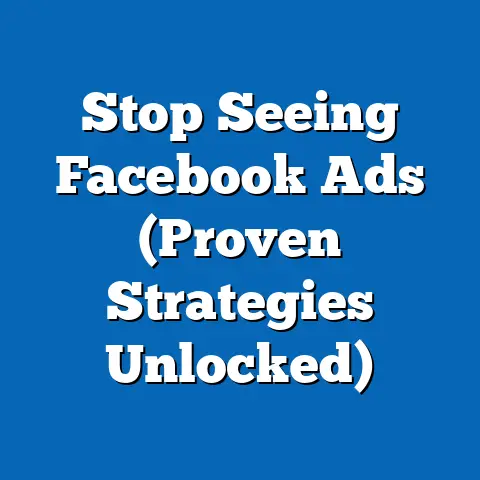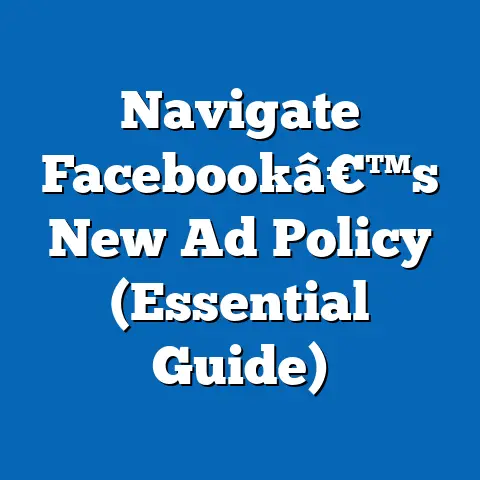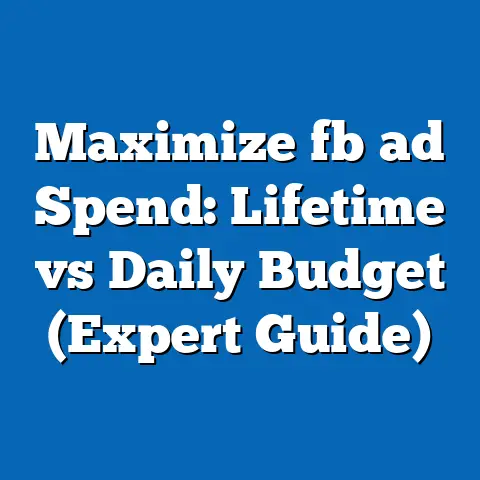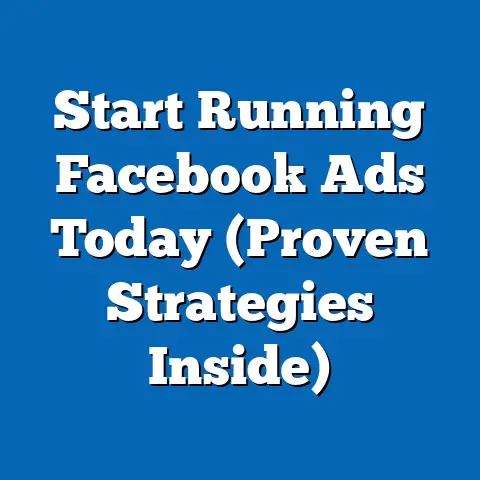Unlock Facebook Ads Approval (Proven Strategies Inside)
Have you ever poured your heart and soul into crafting the perfect Facebook ad campaign, meticulously selecting your target audience, writing compelling copy, and designing eye-catching visuals, only to have it rejected by Facebook? I know I have. It’s a frustrating experience, to say the least. You invest time, energy, and resources, anticipating the influx of leads and sales, only to be met with a cold, impersonal rejection notice. It’s like hitting a brick wall at full speed.
I remember one particular campaign I was working on for a local bakery. We had spent weeks perfecting the creative, highlighting their delicious pastries and personalized cakes. We were targeting users interested in baking, local events, and birthday celebrations. I was convinced this campaign would be a slam dunk. Then, the dreaded notification: “Ad Disapproved.” The reason? A vague reference to “misleading health claims” – apparently, showcasing a picture of a beautifully decorated cake implied it was a health food. Talk about frustrating!
This experience, and many others like it, highlighted a critical truth: success on Facebook Ads isn’t just about great creative and smart targeting. It’s about understanding and navigating the often-complex and sometimes opaque world of Facebook’s advertising policies. Whether you’re a small business owner just starting out, a seasoned marketing professional, or an agency managing multiple accounts, understanding these policies is paramount to your success. Ad rejections can lead to lost revenue, wasted time, and even account restrictions. The emotional toll of constantly battling the approval process can be significant, leading to burnout and frustration.
Section 1: Understanding Facebook’s Advertising Policies
Facebook’s advertising policies are the foundation upon which all successful campaigns are built. These policies are designed to protect users from misleading, offensive, or harmful content, and to ensure a positive advertising experience for everyone. While they can seem daunting at first, understanding the key components is crucial for avoiding ad rejections and maximizing your campaign performance.
Key Components of Facebook’s Advertising Policies
Facebook’s advertising policies are broken down into several key categories, each addressing specific types of content and practices. Let’s explore some of the most important ones:
- Prohibited Content: This section outlines content that is strictly forbidden on the platform. This includes things like:
- Illegal Products or Services: Ads promoting illegal activities, drugs, weapons, or counterfeit goods are strictly prohibited.
- Discriminatory Practices: Ads that discriminate based on race, ethnicity, religion, age, sex, sexual orientation, gender identity, disability, or other protected characteristics are not allowed.
- Misleading or False Content: Ads that contain false, deceptive, or misleading claims are prohibited. This includes exaggerated promises, unsubstantiated health claims, and deceptive pricing.
- Offensive Content: Ads that contain offensive, hateful, or violent content are not permitted. This includes hate speech, bullying, and content that promotes violence or incites hatred.
- Personal Attributes: Ads that directly assert or imply a user’s personal attributes, such as their race, religion, age, sexual orientation, or financial status, are prohibited. For example, an ad that says, “Are you over 50 and looking for life insurance?” would violate this policy.
- Restricted Content: This section outlines content that is allowed under certain conditions and with specific restrictions. This includes things like:
- Alcohol: Ads promoting alcohol must comply with local laws and regulations and must target users of legal drinking age.
- Gambling: Ads promoting gambling must comply with local laws and regulations and must target users of legal gambling age.
- Dating Services: Ads for dating services must be respectful and avoid promoting exploitation or objectification.
- Health and Fitness: Ads promoting health and fitness products or services must not make unsubstantiated claims or promote dangerous practices.
- Financial Products and Services: Ads promoting financial products and services, such as loans or credit cards, must be transparent and avoid misleading claims.
- Community Standards: In addition to the advertising policies, ads must also comply with Facebook’s Community Standards, which outline acceptable behavior and content on the platform. This includes things like:
- Authenticity: Ads must be truthful and transparent about the product or service being advertised.
- Safety: Ads must not promote harm or violence.
- Privacy: Ads must respect users’ privacy and avoid collecting or using personal information without their consent.
- Dignity: Ads must not be offensive, hateful, or discriminatory.
- Illegal Products or Services: Ads promoting illegal activities, drugs, weapons, or counterfeit goods are strictly prohibited.
- Discriminatory Practices: Ads that discriminate based on race, ethnicity, religion, age, sex, sexual orientation, gender identity, disability, or other protected characteristics are not allowed.
- Misleading or False Content: Ads that contain false, deceptive, or misleading claims are prohibited. This includes exaggerated promises, unsubstantiated health claims, and deceptive pricing.
- Offensive Content: Ads that contain offensive, hateful, or violent content are not permitted. This includes hate speech, bullying, and content that promotes violence or incites hatred.
- Personal Attributes: Ads that directly assert or imply a user’s personal attributes, such as their race, religion, age, sexual orientation, or financial status, are prohibited. For example, an ad that says, “Are you over 50 and looking for life insurance?” would violate this policy.
- Alcohol: Ads promoting alcohol must comply with local laws and regulations and must target users of legal drinking age.
- Gambling: Ads promoting gambling must comply with local laws and regulations and must target users of legal gambling age.
- Dating Services: Ads for dating services must be respectful and avoid promoting exploitation or objectification.
- Health and Fitness: Ads promoting health and fitness products or services must not make unsubstantiated claims or promote dangerous practices.
- Financial Products and Services: Ads promoting financial products and services, such as loans or credit cards, must be transparent and avoid misleading claims.
- Authenticity: Ads must be truthful and transparent about the product or service being advertised.
- Safety: Ads must not promote harm or violence.
- Privacy: Ads must respect users’ privacy and avoid collecting or using personal information without their consent.
- Dignity: Ads must not be offensive, hateful, or discriminatory.
Common Reasons Ads Get Rejected
Based on my experience, here are some of the most common reasons why Facebook ads get rejected:
- Violating the 20% Text Rule (Now Obsolete, but Still Relevant in Spirit): While Facebook officially removed the 20% text rule for ad images, images that are cluttered with text are still likely to perform poorly and may raise red flags with the ad review system. Focus on visually appealing images with minimal text.
- Misleading Claims: Making exaggerated or unsubstantiated claims about your product or service is a surefire way to get your ad rejected. Be honest and transparent in your messaging.
- Personal Attributes: As mentioned earlier, directly asserting or implying a user’s personal attributes is a violation of policy. Avoid language that singles out specific groups based on their characteristics.
- Inappropriate Targeting: Targeting audiences in a way that is discriminatory or exploitative can lead to ad rejections. Ensure your targeting is ethical and compliant with Facebook’s policies.
- Poor Image Quality: Blurry, pixelated, or low-resolution images can make your ad look unprofessional and may trigger a rejection. Use high-quality images that are visually appealing and relevant to your ad.
- Landing Page Issues: Your landing page is an extension of your ad, so it must also comply with Facebook’s policies. Ensure your landing page is relevant to your ad, provides clear and accurate information, and does not contain any prohibited content.
- Grammar and Spelling Errors: Poor grammar and spelling can make your ad look unprofessional and may raise red flags with the ad review system. Proofread your ad copy carefully before submitting it.
- Sensational Content: Avoid using sensational or clickbait-style headlines or images in your ads. Facebook prioritizes authentic and informative content.
- Adult Content: Ads that contain sexually suggestive or explicit content are strictly prohibited.
- Circumventing Systems: Trying to bypass Facebook’s ad review system through cloaking, redirects, or other deceptive practices will result in ad rejections and potential account restrictions.
Importance of Compliance and Its Impact on Ad Performance
Compliance with Facebook’s advertising policies is not just about avoiding rejections; it’s also about maximizing your ad performance and building a sustainable advertising strategy. Here’s why:
- Improved Ad Visibility: Ads that comply with Facebook’s policies are more likely to be approved and shown to a wider audience.
- Higher Ad Relevance Score: Facebook rewards ads that provide a positive user experience with a higher relevance score, which can lead to lower costs and better ad placement.
- Reduced Account Restrictions: Repeated violations of Facebook’s policies can lead to account restrictions or even permanent bans. Compliance helps you avoid these penalties and maintain a healthy advertising account.
- Enhanced Brand Reputation: Running compliant ads demonstrates that you are a responsible and ethical advertiser, which can enhance your brand reputation and build trust with your audience.
- Sustainable Advertising Strategy: Building your advertising strategy on a foundation of compliance ensures that you can continue to run successful campaigns on Facebook for the long term.
Examples of Approved and Rejected Ads
To illustrate the importance of compliance, let’s look at some examples of ads that have been successfully approved and those that have been rejected:
Approved Ad Example:
Next Steps: Take some time to review Facebook’s advertising policies in detail. Pay close attention to the sections that are most relevant to your industry and the types of products or services you advertise. Make a checklist of the key points to remember when creating your ads.
Section 2: Preparing Your Ad for Approval
Getting your ad approved by Facebook isn’t just about avoiding policy violations; it’s also about proactively preparing your ad to meet Facebook’s standards and provide a positive user experience. This involves careful planning, attention to detail, and a commitment to transparency and authenticity.
Preparatory Steps Before Submitting Your Ads
Before you even create your ad in Ads Manager, there are several preparatory steps you should take to ensure a smooth approval process:
Be transparent about your pricing, shipping costs, and return policies. If you are running a promotion or offering a discount, be clear about the terms and conditions.
Here are some tips for ensuring clarity and transparency in your messaging:
- Use Simple Language: Avoid using complex or technical language that your target audience may not understand.
- Be Specific: Provide specific details about your product or service, including its features, benefits, and pricing.
- Be Honest: Do not make exaggerated claims or promises that you cannot keep.
- Be Transparent: Be open and honest about your business practices, including your pricing, shipping costs, and return policies.
- Provide Contact Information: Make it easy for users to contact you with questions or concerns.
Importance of High-Quality Images and Correct Ad Formats
Visuals are a critical component of any successful ad campaign. High-quality images and videos can capture attention, convey your message, and drive conversions. Conversely, low-quality or irrelevant visuals can damage your brand reputation and lead to ad rejections.
Here are some tips for using high-quality images and correct ad formats:
- Use High-Resolution Images: Use images that are clear, sharp, and well-lit. Avoid using blurry or pixelated images.
- Choose Relevant Images: Choose images that are relevant to your product or service and your target audience.
- Use the Correct Ad Format: Facebook offers a variety of ad formats, each with its own specifications for image size and resolution. Use the correct ad format for your chosen image.
- Test Different Visuals: Experiment with different images and videos to see what resonates best with your target audience.
- Consider Using Video: Video ads can be highly engaging and effective. If you have the resources, consider creating a video ad to showcase your product or service.
Crafting Compelling Ad Copy That Aligns with Facebook’s Guidelines
Your ad copy is your opportunity to persuade users to take action. It should be clear, concise, and persuasive, highlighting the benefits of your product or service and including a strong call to action. However, it’s crucial to craft compelling ad copy that aligns with Facebook’s guidelines to avoid rejections.
Here are some tips for crafting compelling and compliant ad copy:
- Focus on Benefits: Highlight the benefits of your product or service, rather than just its features. What problem does it solve? How will it improve the user’s life?
- Use Strong Verbs: Use action verbs that encourage users to take action, such as “Shop Now,” “Learn More,” or “Get Started.”
- Create a Sense of Urgency: Create a sense of urgency to encourage users to act quickly. Use phrases like “Limited Time Offer” or “While Supplies Last.”
- Use Social Proof: Incorporate social proof, such as testimonials or reviews, to build trust and credibility.
- Avoid Exaggerated Claims: Do not make exaggerated claims or promises that you cannot keep.
- Avoid Personal Attributes: Do not directly assert or imply a user’s personal attributes, such as their race, religion, age, or sexual orientation.
- Proofread Carefully: Proofread your ad copy carefully for grammar and spelling errors.
Tone, Language, and Call-to-Action Strategies:
- Tone: Maintain a professional and respectful tone in your ad copy. Avoid using offensive, hateful, or discriminatory language.
- Language: Use language that is appropriate for your target audience. Avoid using jargon or technical terms that they may not understand.
- Call to Action: Include a clear and concise call to action that tells users what you want them to do. Make it easy for them to take action by providing a direct link to your website or landing page.
Key Takeaway: Preparing your ad for approval involves careful planning, attention to detail, and a commitment to clarity, transparency, and compliance. By following these steps, you can increase your chances of getting your ads approved and maximizing your campaign performance.
Next Steps: Review your existing ad campaigns and identify any areas where you can improve your ad preparation process. Create a checklist of the steps you need to take before submitting your ads for review.
Section 3: Common Pitfalls and How to Avoid Them
Even with careful planning and preparation, it’s easy to fall into common pitfalls that can lead to ad rejections. Understanding these pitfalls and how to avoid them is crucial for ensuring a smooth and successful advertising experience on Facebook.
Frequent Mistakes That Lead to Ad Disapproval
Here are some of the most frequent mistakes that lead to ad disapproval:
- Misleading Claims: Making exaggerated or unsubstantiated claims about your product or service is a surefire way to get your ad rejected. Be honest and transparent in your messaging.
- Inappropriate Targeting: Targeting audiences in a way that is discriminatory or exploitative can lead to ad rejections. Ensure your targeting is ethical and compliant with Facebook’s policies.
- Poor Image Quality: Blurry, pixelated, or low-resolution images can make your ad look unprofessional and may trigger a rejection. Use high-quality images that are visually appealing and relevant to your ad.
- Landing Page Issues: Your landing page is an extension of your ad, so it must also comply with Facebook’s policies. Ensure your landing page is relevant to your ad, provides clear and accurate information, and does not contain any prohibited content.
- Grammar and Spelling Errors: Poor grammar and spelling can make your ad look unprofessional and may raise red flags with the ad review system. Proofread your ad copy carefully before submitting it.
- Sensational Content: Avoid using sensational or clickbait-style headlines or images in your ads. Facebook prioritizes authentic and informative content.
- Adult Content: Ads that contain sexually suggestive or explicit content are strictly prohibited.
- Personal Attributes: Directly asserting or implying a user’s personal attributes, such as their race, religion, age, or sexual orientation, is a violation of policy.
- Circumventing Systems: Trying to bypass Facebook’s ad review system through cloaking, redirects, or other deceptive practices will result in ad rejections and potential account restrictions.
- Promoting Prohibited Products or Services: Advertising illegal products or services, such as drugs, weapons, or counterfeit goods, is strictly prohibited.
Detailed Strategies for Avoiding These Pitfalls
Here are some detailed strategies for avoiding these common pitfalls:
- Be Honest and Transparent: Avoid making exaggerated claims or promises that you cannot keep. Focus on the benefits of your product or service and provide accurate information.
- Target Responsibly: Ensure your targeting is ethical and compliant with Facebook’s policies. Avoid targeting audiences in a way that is discriminatory or exploitative.
- Use High-Quality Visuals: Use images and videos that are clear, sharp, and well-lit. Choose visuals that are relevant to your product or service and your target audience.
- Optimize Your Landing Page: Ensure your landing page is relevant to your ad, provides clear and accurate information, and does not contain any prohibited content.
- Proofread Carefully: Proofread your ad copy carefully for grammar and spelling errors. Ask someone else to proofread it as well.
- Avoid Sensationalism: Avoid using sensational or clickbait-style headlines or images in your ads. Focus on providing authentic and informative content.
- Stay Away from Adult Content: Do not include sexually suggestive or explicit content in your ads.
- Respect Personal Attributes: Avoid directly asserting or implying a user’s personal attributes in your ad copy or targeting.
- Play by the Rules: Do not try to bypass Facebook’s ad review system through cloaking, redirects, or other deceptive practices.
- Know What’s Prohibited: Familiarize yourself with Facebook’s list of prohibited products and services and avoid advertising them.
Case Studies and Testimonials
Let’s look at a couple of real-world examples:
Case Study 1: The E-commerce Store
An e-commerce store selling handmade jewelry ran into constant ad rejections. After digging deeper, they realized their retargeting ads were the problem. They were using dynamic product ads that showed users the exact item they had viewed on the website, with ad copy that read, “Still thinking about this [product name]?” While seemingly harmless, Facebook flagged these ads as violating the “personal attributes” policy. The solution? They adjusted their ad copy to be more general, focusing on the overall benefits of their jewelry and avoiding direct references to specific products the user had viewed. Ad approvals soared.
Case Study 2: The Local Restaurant
A local restaurant was struggling to get their ads approved due to images that were deemed “too suggestive.” While the images weren’t overtly explicit, they featured close-ups of food that Facebook’s algorithm interpreted as sensual. The restaurant owner initially argued that the images were simply showcasing their delicious food. However, after consulting with a Facebook Ads expert, they realized that perception is key. They swapped out the close-up shots for wider, more inviting images of their restaurant atmosphere and happy customers. The result? Ad approvals skyrocketed, and their campaign performance improved significantly.
Key Takeaway: Avoiding common pitfalls is crucial for ensuring a smooth and successful advertising experience on Facebook. By being honest and transparent, targeting responsibly, using high-quality visuals, optimizing your landing page, proofreading carefully, avoiding sensationalism, staying away from adult content, respecting personal attributes, playing by the rules, and knowing what’s prohibited, you can minimize ad rejections and maximize your campaign performance.
Next Steps: Review your past ad campaigns and identify any instances where you may have fallen into these common pitfalls. Make a list of the specific steps you need to take to avoid these pitfalls in the future.
Section 4: Utilizing Facebook’s Tools and Resources
Facebook provides a variety of tools and resources to help advertisers ensure compliance and maximize their campaign performance. Learning how to leverage these tools effectively can significantly reduce the risk of ad rejections and improve your overall advertising ROI.
Facebook Ads Manager
The Facebook Ads Manager is your central hub for creating, managing, and analyzing your Facebook ad campaigns. It provides a wealth of features and tools to help you optimize your ads for success.
Here are some of the key features of the Facebook Ads Manager that can help you ensure compliance:
- Policy Check: The Ads Manager includes a built-in policy check that scans your ad copy and visuals for potential violations of Facebook’s advertising policies. This tool can help you identify and address potential issues before submitting your ad for review.
- Ad Preview: The Ad Preview tool allows you to see how your ad will look on different placements, such as the Facebook News Feed, Instagram Feed, and Audience Network. This can help you ensure that your ad is visually appealing and that your message is clear and concise.
- Audience Insights: Audience Insights provides valuable data about your target audience, including their demographics, interests, and behaviors. This information can help you create more relevant and engaging ads that are less likely to be rejected.
- Reporting: The Ads Manager provides detailed reporting on your ad performance, including metrics such as reach, impressions, clicks, and conversions. This data can help you identify areas where you can improve your ads and optimize your campaigns for better results.
Ad Preview Tool
The Ad Preview tool is an invaluable resource for ensuring that your ads are visually appealing and that your message is clear and concise. It allows you to see how your ad will look on different placements, such as the Facebook News Feed, Instagram Feed, and Audience Network.
Here are some tips for using the Ad Preview tool effectively:
- Check Different Placements: Preview your ad on all of the placements where you plan to run it. This will help you ensure that your ad looks good on all devices and platforms.
- Test Different Visuals: Experiment with different images and videos to see what looks best on different placements.
- Review Your Ad Copy: Read your ad copy carefully to ensure that it is clear, concise, and persuasive.
- Check Your Call to Action: Make sure your call to action is clear and easy to understand.
- Get Feedback: Ask someone else to review your ad preview and provide feedback.
Creative Hub
The Creative Hub is a tool that allows you to create and test different ad creatives, such as images, videos, and ad copy. It also provides inspiration and best practices for creating effective ads.
Here are some of the key features of the Creative Hub:
- Mockup Tool: The Mockup Tool allows you to create mockups of your ads to see how they will look on different placements.
- Creative Inspiration: The Creative Hub provides a gallery of inspiring ad examples from other advertisers.
- Best Practices: The Creative Hub provides best practices for creating effective ads, including tips on image selection, ad copy, and targeting.
- Collaboration: The Creative Hub allows you to collaborate with other members of your team on ad creatives.
Facebook Business Help Center and Online Communities
The Facebook Business Help Center is a comprehensive resource that provides answers to common questions about Facebook advertising. It also includes tutorials, best practices, and troubleshooting tips.
In addition to the Business Help Center, there are many online communities where you can connect with other advertisers, ask questions, and share your experiences. These communities can be a valuable source of support and guidance.
Here are some popular Facebook advertising communities:
- Facebook Ads Experts Community: A large and active community of Facebook advertising experts.
- Facebook Ads Mastery: A group focused on advanced Facebook advertising strategies.
- Social Media Marketing Society: A broader community focused on all aspects of social media marketing.
Key Takeaway: Facebook provides a wealth of tools and resources to help advertisers ensure compliance and maximize their campaign performance. By learning how to leverage these tools effectively, you can significantly reduce the risk of ad rejections and improve your overall advertising ROI.
Next Steps: Explore the Facebook Ads Manager, Ad Preview tool, Creative Hub, and Business Help Center. Join a Facebook advertising community and start connecting with other advertisers.
Section 5: Post-Approval Best Practices
Getting your ad approved is just the first step. Maintaining compliance throughout the campaign and staying updated on changes to Facebook’s advertising policies are crucial for long-term success.
Maintaining Compliance Throughout the Campaign
Once your ad is approved, it’s important to monitor its performance and make necessary adjustments to ensure that it continues to comply with Facebook’s advertising policies.
Here are some tips for maintaining compliance throughout the campaign:
- Monitor Ad Performance: Regularly monitor your ad performance for any signs of policy violations. Pay attention to metrics such as ad relevance score, click-through rate, and conversion rate.
- Review User Feedback: Pay attention to user feedback, such as comments and shares. If users are reporting your ad for policy violations, take action immediately.
- Update Your Ad Copy and Visuals: If your ad is no longer performing well or if it is starting to violate Facebook’s policies, update your ad copy and visuals.
- Adjust Your Targeting: If your ad is reaching the wrong audience or if it is targeting users in a way that is discriminatory or exploitative, adjust your targeting options.
- Pause or Delete Non-Compliant Ads: If you identify an ad that is violating Facebook’s policies, pause or delete it immediately.
Staying Updated on Changes to Facebook’s Advertising Policies
Facebook’s advertising policies are constantly evolving. It’s important to stay updated on these changes and adapt your strategies accordingly.
Here are some tips for staying updated on changes to Facebook’s advertising policies:
- Subscribe to Facebook’s Advertising Updates: Subscribe to Facebook’s advertising updates to receive notifications about policy changes.
- Follow Facebook’s Advertising Blog: Follow Facebook’s advertising blog for insights and best practices.
- Join Facebook Advertising Communities: Join Facebook advertising communities to stay informed about the latest news and trends.
- Attend Industry Events: Attend industry events to learn about the latest Facebook advertising strategies and best practices.
Adapting Strategies Accordingly
When Facebook’s advertising policies change, it’s important to adapt your strategies accordingly. This may involve updating your ad copy, visuals, targeting options, or landing pages.
Here are some tips for adapting your strategies to changes in Facebook’s advertising policies:
- Review the Policy Changes: Carefully review the policy changes to understand how they will affect your ads.
- Identify Affected Ads: Identify any ads that may be affected by the policy changes.
- Update Your Ads: Update your ad copy, visuals, targeting options, or landing pages to comply with the new policies.
- Test Your Ads: Test your updated ads to ensure that they are still performing well.
- Monitor Your Results: Monitor your results to see how the policy changes are affecting your campaign performance.
Key Takeaway: Maintaining compliance throughout the campaign and staying updated on changes to Facebook’s advertising policies are crucial for long-term success. By following these best practices, you can ensure that your ads continue to comply with Facebook’s guidelines and that your campaigns remain effective.
Next Steps: Subscribe to Facebook’s advertising updates, follow Facebook’s advertising blog, and join Facebook advertising communities. Review your existing ad campaigns and identify any areas where you need to adapt your strategies to comply with the latest policy changes.
Conclusion
Navigating the Facebook Ads approval process can feel like a daunting task, filled with potential pitfalls and ever-changing policies. I know it has for me, countless times. But, as I’ve shown you in this guide, it’s not an insurmountable challenge. By understanding the intricacies of Facebook’s advertising policies, proactively preparing your ads for success, avoiding common mistakes, and leveraging the powerful tools and resources Facebook provides, you can significantly increase your chances of getting your ads approved and unlocking the full potential of Facebook advertising.
Remember, compliance isn’t just about avoiding rejections; it’s about building a sustainable and ethical advertising strategy that benefits both your business and your audience. It’s about fostering trust, enhancing your brand reputation, and creating a positive user experience.
I encourage you to implement the proven strategies outlined in this article in your own Facebook ad campaigns. Take the time to review Facebook’s advertising policies, prepare your ads carefully, and monitor your results closely. Stay updated on policy changes and adapt your strategies accordingly.
While the journey may have its bumps along the way, with the right knowledge and preparation, you can confidently navigate the Facebook Ads approval process and achieve your advertising goals. So, go out there, create compelling and compliant ads, and unlock the power of Facebook advertising to drive your business forward. Good luck!






